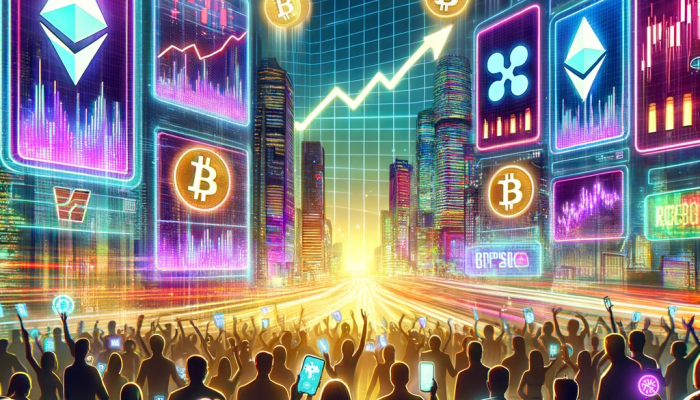In the ever-evolving world of technology, one term has recently stolen the spotlight – NFTs, or Non-Fungible Tokens. You might have heard of NFTs in the context of digital art, but did you know that these digital wonders have use cases that go way beyond that? Whether you’re a tech-savvy enthusiast or just casually curious, join us as we explore the exciting world of NFTs and their expanding use cases.
What Are NFTs?
NFTs, or Non-Fungible Tokens, are digital assets representing ownership of authenticity of a specific item or piece of content using blockchain technology. In contrast to cryptocurrencies such as Ethereum or Bitcoin, NFTs are not interchangeable on a one-to-one basis.
Some of the key features of NFTs include:
- Unique Digital Assets: NFTs are unique digital assets representing ownership or proof of authenticity of a specific item or piece of content, like art, music, videos, virtual real estate, collectibles, and even tweets.
- Built on Blockchain: NFTs are built on blockchain technology, like a secure digital ledger. Blockchain ensures the scarcity and uniqueness of NFTs by recording all transactions transparently and tamper-proof.
- Ownership and Provenance: NFTs establish ownership and provenance. When you own an NFT, you have a digital certificate that proves you own a specific digital item. It’s like having a digital signature that says, “This is mine!”
- Token Standards: NFTs follow specific token standards, such as ERC-721 or ERC-1155 on the Ethereum blockchain. These standards define NFTs’ behavior and are critical for compatibility across platforms and marketplaces.
- Smart Contracts: Smart contracts are self-executing agreements that play a pivotal role in NFTs by defining the rules and conditions of ownership and transfer. When you buy an NFT, a smart contract automatically transfers ownership to your digital wallet.
- Digital Wallets: You need a digital wallet to own and manage NFTs. It’s like your digital safe, where you store your unique tokens. Popular wallets include MetaMask, Trust Wallet, and Coinbase Wallet.
A Brief History of NFTs
Before jumping into the present and future of NFTs, it is important to look at the past. The history of Non-Fungible Tokens (NFTs) is a journey that began with the desire to create digital uniqueness and ownership in an increasingly digital world. While the concept of NFTs has been around for a while, their popularity has skyrocketed in recent years.
NFTs owe their origins to the early experiments with blockchain technology and the concept of digital scarcity. The groundwork for NFTs was laid by introducing the Colored Coins project on the Bitcoin blockchain in 2012, where users attempted to represent unique assets using Bitcoin transactions.
However, it was not until 2017 that Ethereum’s blockchain, with its smart contract capabilities, truly unlocked the potential of NFTs. CryptoKitties, a blockchain-based game, became a sensation, allowing users to buy, sell, and breed unique virtual cats. This marked the birth of NFTs as we know them today.
Since then, NFTs have taken off in various forms, from digital art sales reaching astronomical prices to virtual real estate ownership, collectibles, music, and gaming items. In 2021, Beeple’s “Everydays: The First 5000 Days” artwork sold for $69 million, shattering records and cementing NFTs’ place in the art world. With each passing day, NFTs continue to evolve, offering unique opportunities, challenges, and a glimpse into the future of digital ownership and creativity.
Top Use Cases of NFTs
While considerably new to the digital world, the use cases of NFTs have continued to develop rapidly. Below are some of the biggest use cases of NFTs.
1. NFTs in Digital Art
One of the most popular use cases for NFTs is in the world of digital art. Established and emerging artists have flocked to NFT platforms to showcase and sell their creations. NFTs provide a way to prove ownership and authenticity, addressing the age-old problem of digital art piracy. Some NFT art pieces have sold for jaw-dropping amounts, turning digital artists into overnight millionaires.
2. Music and NFTs
Musicians have also jumped on the NFT bandwagon. Artists like Kings of Leon have released their albums as NFTs, giving fans exclusive perks like VIP concert tickets and backstage access. This innovative approach can potentially revolutionize how musicians interact with their audience and monetize their work.
3. Collectibles and NFTs
Remember collecting baseball cards or Pokémon cards as a kid? Well, NFTs have breathed new life into the concept of collectibles. One main use case of NFTs is returning to the joy of collecting art. Digital trading cards, collectible items in video games, and even virtual sneakers are now being minted as NFTs, creating a whole new world of digital collectibles.
4. Virtual Real Estate and NFTs
One of the biggest use cases of NFTs is the ability to buy virtual real estate. Yes, you read that right – virtual real estate. In the digital realm, NFTs can represent ownership of virtual land within metaverse platforms like Decentraland or The Sandbox.
Just like in the physical world, people buy, sell, and develop virtual properties, and it’s a burgeoning market with vast potential.
5. Securing Creativity
NFTs provide a haven for protecting intellectual property. Mint your creations as NFTs to safeguard your work and receive royalties with each resale. You don’t have to be restricted by a canvas and paintbrush. Let your creativity flow with NFTs. It’s a digital-age solution for artists, writers, and innovators.
6. NFTs in Gaming
Gaming is, arguably, one of the biggest use cases of NFTs. Gaming has always been at the forefront of technological innovation, and NFTs are no exception.
In games like Axie Infinity, players can buy, sell, and trade in-game assets as NFTs. This has created opportunities for players to earn real money while playing, blurring the lines between gaming and investing.
7. NFTs in Fashion
Fashion brands are exploring NFTs to offer unique digital fashion items. These digital wearables can be used in virtual worlds or even in augmented reality (AR) applications. Owning a limited-edition NFT fashion piece can be a status symbol in the digital fashion landscape, much like owning a Chanel purse or a Rolex watch.
8. Intellectual Property and NFTs
NFTs are also being used to protect and manage intellectual property rights. Content creators can mint their work as NFTs, ensuring they receive royalties every time their creations are resold. This can potentially revolutionize copyright and intellectual property in the digital age.
9. NFTs and Charity
Charities have found innovative ways to leverage NFTs for fundraising. They can mint unique NFTs and auction them off, with the proceeds going to their cause. This not only raises funds but also creates a sense of community and involvement among supporters. Moreover, an NFT is a visible sign of someone being generous.
The Future of NFTs
The current use cases of NFTs aren’t the only thing you must look at. The future of NFTs is full of possibilities that promise even greater use cases. Below are some of the most sought-after future use cases of NFTs.
1. NFTs for Identity and Authentication
NFTs are a game-changer for identity verification and authentication. Blockchain technology can securely store and verify your digital identity, documents, and credentials. Say goodbye to the endless paper trails and cumbersome verification processes.
2. Sustainability and NFTs
The environmental impact of blockchain technology has raised concerns. The future of NFTs will likely shift towards more eco-friendly blockchain solutions, ensuring that the digital world coexists harmoniously with our planet.
3. Education and Certification
NFTs will revolutionize the way we learn and prove our skills. Imagine earning NFT certificates for completing courses, which you can showcase in your digital portfolio. Employers can verify these credentials efficiently, making job applications a breeze.
4. Medical Records and Security
Imagine a world where your medical records are securely stored on the blockchain, accessible only to authorized personnel. One of the future Use cases of NFTs involves creating unique tokens representing your medical history, ensuring the privacy and security of your sensitive information. These tokens can grant access to doctors, specialists, and hospitals when needed, revolutionizing how healthcare data is managed.
5. Medical Research and Funding
NFTs have introduced a novel way of funding medical research through tokenization. Researchers can mint NFTs representing their projects, allowing investors and philanthropists to support specific studies directly. This democratizes the funding process, making it easier for groundbreaking research to receive the financial backing it deserves.
6. Digital Ownership and Car History
One of the most desirable future use cases of NFTs is vehicle ownership. Have you ever wondered about a car’s history, like who owned it before or where it’s been? NFTs are here to provide a digital logbook of a vehicle’s journey. Car manufacturers and dealerships are exploring using NFTs to track a car’s history, maintenance records, and ownership. It’s like a car’s autobiography stored on the blockchain for all to see!
Challenges and Considerations
While the world of NFTs is exciting and full of possibilities, it’s not without challenges. Environmental concerns related to the energy consumption of blockchain networks and issues of copyright infringement have raised important questions that must be addressed.
However, some of the main challenges that NFTs will have to overcome include:
- Lack of Regulation: The NFT market is currently largely unregulated, leaving room for scams, copyright infringements, and fraud. Buyers must exercise caution.
- High Volatility: The value of NFTs can be highly volatile, with prices subject to rapid fluctuations. This makes them a risky investment, and some people may experience losses.
- Exclusivity and Access: While NFTs can provide unique experiences, they can also create digital exclusivity, potentially limiting access to certain content or experiences to those who can afford them.
- Copyright Challenges: NFTs have sparked debates about copyright infringement, as some creators may mint NFTs of work they do not own the rights to, leading to legal disputes and ethical dilemmas.
How to Get Started with NFTs
Understanding the use cases of NFTs is part of the process when you get started with NFTs. However, there are many other factors that you must prepare for.
1. Setting Up a Digital Wallet
Think of a digital wallet as your treasure chest for NFTs. You’ll need one to store, buy, and sell NFTs. A popular wallet option among NFT beginners is the Coinbase Wallet. Coinbase Wallet is a user-friendly platform for managing NFTs (Non-Fungible Tokens). It offers a secure and intuitive interface to store, send, and receive NFTs. With its ease of use and integration with various NFT marketplaces, Coinbase Wallet is a convenient choice for both newcomers and seasoned collectors in the NFT space.
2. Buying Cryptocurrency
To start your NFT journey, you’ll need some cryptocurrency, typically Ethereum (ETH). Most NFT transactions happen on Ethereum’s blockchain. So, head to a cryptocurrency exchange like Coinbase or Binance, create an account, and buy some ETH. Transfer it to your digital wallet.
3. Exploring NFT Marketplaces
NFTs are bought and sold on NFT marketplaces, which are like digital auction houses. Explore these platforms, browse the vast array of NFTs, and discover what catches your eye.
4. Creating an Account
To participate in NFT marketplaces, you’ll need to create an account. Sign up with your email address, connect your digital wallet, and follow the verification steps. Remember, security is essential, so use strong passwords and enable two-factor authentication if available.
5. Minting Your NFT
If you’re an artist or content creator, you can mint your NFTs to sell. Minting means turning your digital creation into an NFT. Different platforms have varying minting processes, so follow the instructions on your chosen marketplace to create your NFT.
6. Bidding and Buying NFTs
Ready to start collecting NFTs? Browse the marketplace, find an NFT you love, and place a bid or make a direct purchase. When you buy an NFT, it will be transferred to your digital wallet, and you’ll officially own a piece of the digital universe.
7. Storing and Managing NFTs
Your digital wallet is your vault of NFT treasures. Ensure you have a secure backup of your wallet’s recovery phrase. This is crucial because losing access to your wallet means losing your NFTs. Organize your collection, view your NFTs, and admire your digital artistry!
8. Selling Your NFTs
If you decide to part with an NFT, you can list it for sale on the marketplace. Set your desired price or choose an auction format. Once a buyer agrees to your terms, the NFT will be transferred to their wallet, and you’ll receive the proceeds in cryptocurrency.
9. Staying Informed
The NFT space is ever-evolving, and the use cases of NFTs are endless. To stay in the loop, follow NFT news, artists, and communities on social media. Engaging with fellow enthusiasts can help you learn, discover new opportunities, and grow your NFT knowledge.
Why Invest in NFTs
Among the many use cases of NFTs, investment is perhaps the biggest and most popular use case. Below are some of the main reasons why investment is one of the biggest use cases of NFTs:
1. The Unique Appeal of NFTs
NFTs represent ownership or proof of authenticity of digital assets, making them ideal for scarce, unique, and collectible items. Unlike cryptocurrencies, NFTs cannot be exchanged on a one-to-one basis. This uniqueness is a game-changer in the world of digital assets.
2. Scarcity and Authenticity
NFTs use blockchain technology to establish scarcity and authenticity. Each NFT is traceable on the blockchain, which verifies its ownership and provenance. This transparency and security make NFTs appealing to collectors, as they can be sure of the item’s origin and scarcity.
3. Diversification of Investment Portfolios
Investors are diversifying their portfolios by including NFTs. The traditional investment landscape, while tried and tested, is being expanded to include digital assets. NFTs offer a novel way to hedge against traditional market volatility and add diversity to an investment strategy.
4. Proven Investment Potential
NFTs have shown impressive investment potential. Some NFTs have appreciated significantly in value, turning early buyers into digital millionaires. While NFTs come with risks, their investment track record has piqued the interest of many.
5. Access to Unique Experiences
Investing in NFTs can grant you access to unique experiences and perks. Musicians offer NFT buyers exclusive concert tickets and backstage passes, while artists offer behind-the-scenes access to their creative process. Owning NFTs can be like joining an exclusive club with special privileges.
6. Supporting Creators
Investing in NFTs isn’t just about profits; it’s also about supporting creators. When you buy an NFT, you’re directly supporting the artist or content creator. Many creators receive royalties when their NFTs are resold, creating a sustainable income stream.
Summing Up the NFT Revolution
In a relatively short period, NFTs have expanded beyond digital art to infiltrate various industries, from music to fashion, gaming, and even virtual real estate. The future of NFTs is promising, potentially reshaping how we think about ownership and authenticity in the digital age. As technology continues to advance, who knows what new use cases for NFTs will emerge? The NFT revolution is just beginning, and the possibilities are endless.






